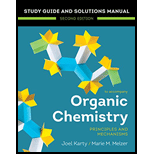
Interpretation:
The number of elementary steps in the mechanism represented by the given free energy diagram is to be determined. The number of locations in the energy diagram that represent intermediates is to be determined. The locations of the overall reactants (R), intermediates (I), transition states (TS), and overall products (P) on the diagram are to be marked.
Concept introduction:
For a mechanism that contains n total elementary steps, there must be n total transition states. Because an intermediate is located in between two transition states, there must be n – 1 locations in the energy diagram that represent intermediates. Transition states are present at energy maxima. Intermediates appear at energy minima.
Want to see the full answer?
Check out a sample textbook solution
Chapter 8 Solutions
EBK ORGANIC CHEMISTRY: PRINCIPLES AND M
- Clearly label the energy diagram below when answering each part. If there is more than one specific type of label, give an appropriate number afterwards (i.e. Int. 1, Int. 2, etc). State how many step(s) are in the overall reaction, if more than one, clearly label where they start and end Identify the rate determining step (rds) Label all transition state(s) (TS) Label all intermediate(s) (Int.) Label all activation energy(ies) (Ea) Label the heat of the reaction (ΔH) State whether the overall reaction is endothermic or exothermic. please explaing each step. Thank you.arrow_forwardWhich of the following is the rate-limiting step of a reaction? A) the fastest step in the reaction mechanism B) the slowest step in a reaction mechanism C) the last step in the reaction mechanism D) none of the abovearrow_forwardRank the relative rates of the three steps for the multistep mechanism. Step1, step 2, step 3 Which step have slowest and fastest relative speedarrow_forward
- •OOH H H atom abstraction Consider the hydrogen atom abstraction step in an autooxidation mechanism, as shown above. Which of the following represents the intermediate that is formed in this step? OOH ? .00.arrow_forwardConsider the mechanism for 1,2 and 1,4 addition reactions. If the cation intermediate is the same in energy on the reaction coordinate diagram, how do different products form selectively? Alkene stability dictates the reaction. Reaction conditions control which product is formed. The transition state: once the new bonds start to form, the cations are no longer in resonance and the transition states become different in energy. Activation energy distinguishes the products.arrow_forward5. Give all the product(s) (label major and minor), reaction description (SN1, SN2, E1, or E2), and rate law (equation) for each reaction. H20 heat Кон DMFarrow_forward
- The equilibrium constant for reversible reactions is equal to a) [Products]/[Reagents] [Reagents] [Reagents] [Productsb) [Reagents]/[Products] [Products]/[Reagents].c) [Products]/[Products].arrow_forwardFor each reaction in question 20, sketch a reaction coordinate energy diagram indicating the starting materials, transition states and any intermediates, if present, in the reaction. Don't worry about the absolute energy of starting materials and products but you can assume that the product is more stable than the starting materials.arrow_forward78:-Sketch an energy diagram for a one-step reaction that is fast and highly exergonic.arrow_forward
- Predict the relative rates of these reactions. That is, select 1 next to the reaction with the fastest rate, 2 next to the reaction with the next fastest rate, and so on. Note for advanced students: you may assume these reactions all take place in a polar aprotic solvent, like DMSO. ( Choose one) Predict the relative rates of these reactions. That is, select 1 next to the reaction with the fastest rate, 2 next to the reaction with the next fastest rate, and so on. Note for advanced students: you may assume these reactions all take place in a polar aprotic solvent, like DMSO. u + H₂O Reaction - OH₂ Relative Rate (Choose one) OH₂ (Choose one) ▼ +CI ... + H₂O OH + OH + I (Choose one) (Choose one) ▼ + H₂S + CIarrow_forwardSave Answer In an endothermic single step reaction, the transition state is a late transition state. In this case, the transition state does not resembles structurally the product of the reaction O True O Falsearrow_forwardQ1. Draw the reaction mechanism using curly arrows to show each bond made/broken in the production of biodiesel from vegetable oil. Q2. NaOH is in a catalytic amount, why is it not needed in equimolar amount to the Methanol?arrow_forward
 Organic Chemistry: A Guided InquiryChemistryISBN:9780618974122Author:Andrei StraumanisPublisher:Cengage Learning
Organic Chemistry: A Guided InquiryChemistryISBN:9780618974122Author:Andrei StraumanisPublisher:Cengage Learning
